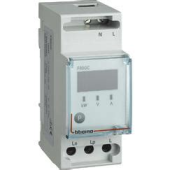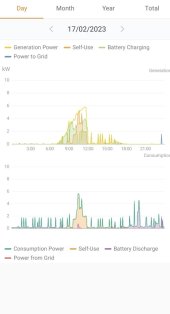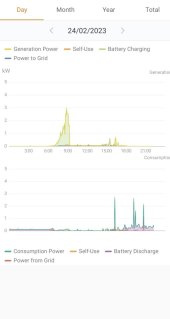Hello Friends,
I've finally got the FV in place.
Specs are:
x17 Longi Solar 415Wp
x1 Solis S5-EH1P3.6 K-L hybrid
x3 Pylontech US3000
As I'm starting to get the hang of how it works so a number of big and small issues are flocking.
Let's go in order:
1. Whenever I disconnect/shut down grid connection the inverter will cease all activities giving "no grid" error. At the moment all house load is connected to the AC-GRID connector. Can this be solved just by switching connector from AC-GRID to AC-BACKUP? Does the "storage mode" in advanced settings have any role in this?
2. I have a cold room in the basement (the house is a loft to the 3rd floor) and I am not sure whether it is connected to the FV system.
Let me clarify: the energy provider meter/switch is located in the basement, from it one line goes up to the house (to the main switch at whose exit the house line and inverter are connected - in parallel) and another line serves the basement.
Could it be that the cold room does actually tap into the FV but the Inverter has no way to know that? Does is have anything to do with where the CT is placed (currently in the main switch with direction toward grid - an Eastron SDM120CT)?
Actually I'm curious how the inverter is able to override grid in favour of FV and batteries.
3. I have been sold this inverter as a 6 kW thinking that it could both take and give 6 kW, but after checking the specs it seems it is not the case.


So what does "Rated Output Power" 3.6 kW mean?
Does it mean that if for instance domestic load is 5 kW and the modules are producing 6 kW at full irradiation, only 3.6 kW can actually get out from the inverter; the rest has to be taken from the grid regardless and the remaining go to the battery if needed or otherwise lost to grid? I'll give it a try tomorrow..
If this is the case I have the same issue discussed here https://diysolarforum.com/threads/new-solis-inverter-setup-with-batteries.43285/, and as it was pointed out in the thread, if someone is planning to harness all the solar power produced in the morning by using a couple of aircons, oven, induction hob, dishwasher, ect., having only 3.6 kW max available makes little sense.
4. I am using Solis Cloud as remote monitoring. It gives okay charts but the update rate is ridiculous. I noticed there is another app called Solis TechView supposedly from the same company. I tried to set up an account but it doen't seem to recognize wifi data logging SN.



5. In the Inverter main screen top left corner I see the message "LmtByEPM" cyclically. Here what the manual says:

I wonder if this is just to notify that the 6.6.7 Export power Set option in the advanced settings is set to off, therefore export to grid is cut (in my case to zero). If that is the case it is okay as I set it that way for the time being.
Thank you in advance for your support!!!
I've finally got the FV in place.
Specs are:
x17 Longi Solar 415Wp
x1 Solis S5-EH1P3.6 K-L hybrid
x3 Pylontech US3000
As I'm starting to get the hang of how it works so a number of big and small issues are flocking.
Let's go in order:
1. Whenever I disconnect/shut down grid connection the inverter will cease all activities giving "no grid" error. At the moment all house load is connected to the AC-GRID connector. Can this be solved just by switching connector from AC-GRID to AC-BACKUP? Does the "storage mode" in advanced settings have any role in this?
2. I have a cold room in the basement (the house is a loft to the 3rd floor) and I am not sure whether it is connected to the FV system.
Let me clarify: the energy provider meter/switch is located in the basement, from it one line goes up to the house (to the main switch at whose exit the house line and inverter are connected - in parallel) and another line serves the basement.
Could it be that the cold room does actually tap into the FV but the Inverter has no way to know that? Does is have anything to do with where the CT is placed (currently in the main switch with direction toward grid - an Eastron SDM120CT)?
Actually I'm curious how the inverter is able to override grid in favour of FV and batteries.
3. I have been sold this inverter as a 6 kW thinking that it could both take and give 6 kW, but after checking the specs it seems it is not the case.


So what does "Rated Output Power" 3.6 kW mean?
Does it mean that if for instance domestic load is 5 kW and the modules are producing 6 kW at full irradiation, only 3.6 kW can actually get out from the inverter; the rest has to be taken from the grid regardless and the remaining go to the battery if needed or otherwise lost to grid? I'll give it a try tomorrow..
If this is the case I have the same issue discussed here https://diysolarforum.com/threads/new-solis-inverter-setup-with-batteries.43285/, and as it was pointed out in the thread, if someone is planning to harness all the solar power produced in the morning by using a couple of aircons, oven, induction hob, dishwasher, ect., having only 3.6 kW max available makes little sense.
4. I am using Solis Cloud as remote monitoring. It gives okay charts but the update rate is ridiculous. I noticed there is another app called Solis TechView supposedly from the same company. I tried to set up an account but it doen't seem to recognize wifi data logging SN.



5. In the Inverter main screen top left corner I see the message "LmtByEPM" cyclically. Here what the manual says:

I wonder if this is just to notify that the 6.6.7 Export power Set option in the advanced settings is set to off, therefore export to grid is cut (in my case to zero). If that is the case it is okay as I set it that way for the time being.
Thank you in advance for your support!!!
Attachments
Last edited:










